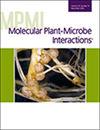Alexandra Margets, Jessica Foster, Anil Kumar, Tom R Maier, Rick Masonbrink, Joffrey Mejias, Thomas J Baum, Roger W Innes
求助PDF
{"title":"大豆孢囊线虫效应因子半胱氨酸蛋白酶 1 (CPR1) 的靶标是线粒体大豆支链氨基酸氨基转移酶 (GmBCAT1)。","authors":"Alexandra Margets, Jessica Foster, Anil Kumar, Tom R Maier, Rick Masonbrink, Joffrey Mejias, Thomas J Baum, Roger W Innes","doi":"10.1094/MPMI-06-24-0068-R","DOIUrl":null,"url":null,"abstract":"<p><p>The soybean cyst nematode (SCN; <i>Heterodera glycines</i>) facilitates infection by secreting a repertoire of effector proteins into host cells to establish a permanent feeding site composed of a syncytium of root cells. Among the diverse proteins secreted by the nematode, we were specifically interested in identifying proteases to pursue our goal of engineering decoy substrates that elicit an immune response when cleaved by an SCN protease. We identified a cysteine protease that we named Cysteine Protease 1 (CPR1), which was predicted to be a secreted effector based on transcriptomic data obtained from SCN esophageal gland cells, the presence of a signal peptide, and the lack of transmembrane domains. CPR1 is conserved in all isolates of SCN sequenced to date, suggesting it is critical for virulence. Transient expression of CPR1 in <i>Nicotiana benthamiana</i> leaves suppressed cell death induced by a constitutively active nucleotide binding leucine-rich repeat protein, RPS5, indicating that CPR1 inhibits effector-triggered immunity. CPR1 localizes in part to the mitochondria when expressed in planta. Proximity-based labeling in transgenic soybean roots, co-immunoprecipitation, and cleavage assays identified a branched-chain amino acid aminotransferase from soybean (GmBCAT1) as a substrate of CPR1. Consistent with this, GmBCAT1 also localizes to mitochondria. Silencing of the <i>CPR1</i> transcript in the nematode reduced penetration frequency in soybean roots, while the expression of <i>CPR1</i> in soybean roots enhanced susceptibility. Our data demonstrates that CPR1 is a conserved effector protease with a direct target in soybean roots, highlighting it as a promising candidate for decoy engineering. [Formula: see text] Copyright © 2024 The Author(s). This is an open access article distributed under the CC BY-NC-ND 4.0 International license.</p>","PeriodicalId":19009,"journal":{"name":"Molecular Plant-microbe Interactions","volume":" ","pages":"751-764"},"PeriodicalIF":3.4000,"publicationDate":"2024-11-01","publicationTypes":"Journal Article","fieldsOfStudy":null,"isOpenAccess":false,"openAccessPdf":"","citationCount":"0","resultStr":"{\"title\":\"The Soybean Cyst Nematode Effector Cysteine Protease 1 (CPR1) Targets a Mitochondrial Soybean Branched-Chain Amino Acid Aminotransferase (GmBCAT1).\",\"authors\":\"Alexandra Margets, Jessica Foster, Anil Kumar, Tom R Maier, Rick Masonbrink, Joffrey Mejias, Thomas J Baum, Roger W Innes\",\"doi\":\"10.1094/MPMI-06-24-0068-R\",\"DOIUrl\":null,\"url\":null,\"abstract\":\"<p><p>The soybean cyst nematode (SCN; <i>Heterodera glycines</i>) facilitates infection by secreting a repertoire of effector proteins into host cells to establish a permanent feeding site composed of a syncytium of root cells. Among the diverse proteins secreted by the nematode, we were specifically interested in identifying proteases to pursue our goal of engineering decoy substrates that elicit an immune response when cleaved by an SCN protease. We identified a cysteine protease that we named Cysteine Protease 1 (CPR1), which was predicted to be a secreted effector based on transcriptomic data obtained from SCN esophageal gland cells, the presence of a signal peptide, and the lack of transmembrane domains. CPR1 is conserved in all isolates of SCN sequenced to date, suggesting it is critical for virulence. Transient expression of CPR1 in <i>Nicotiana benthamiana</i> leaves suppressed cell death induced by a constitutively active nucleotide binding leucine-rich repeat protein, RPS5, indicating that CPR1 inhibits effector-triggered immunity. CPR1 localizes in part to the mitochondria when expressed in planta. Proximity-based labeling in transgenic soybean roots, co-immunoprecipitation, and cleavage assays identified a branched-chain amino acid aminotransferase from soybean (GmBCAT1) as a substrate of CPR1. Consistent with this, GmBCAT1 also localizes to mitochondria. Silencing of the <i>CPR1</i> transcript in the nematode reduced penetration frequency in soybean roots, while the expression of <i>CPR1</i> in soybean roots enhanced susceptibility. Our data demonstrates that CPR1 is a conserved effector protease with a direct target in soybean roots, highlighting it as a promising candidate for decoy engineering. [Formula: see text] Copyright © 2024 The Author(s). This is an open access article distributed under the CC BY-NC-ND 4.0 International license.</p>\",\"PeriodicalId\":19009,\"journal\":{\"name\":\"Molecular Plant-microbe Interactions\",\"volume\":\" \",\"pages\":\"751-764\"},\"PeriodicalIF\":3.4000,\"publicationDate\":\"2024-11-01\",\"publicationTypes\":\"Journal Article\",\"fieldsOfStudy\":null,\"isOpenAccess\":false,\"openAccessPdf\":\"\",\"citationCount\":\"0\",\"resultStr\":null,\"platform\":\"Semanticscholar\",\"paperid\":null,\"PeriodicalName\":\"Molecular Plant-microbe Interactions\",\"FirstCategoryId\":\"99\",\"ListUrlMain\":\"https://doi.org/10.1094/MPMI-06-24-0068-R\",\"RegionNum\":3,\"RegionCategory\":\"生物学\",\"ArticlePicture\":[],\"TitleCN\":null,\"AbstractTextCN\":null,\"PMCID\":null,\"EPubDate\":\"2024/11/26 0:00:00\",\"PubModel\":\"Epub\",\"JCR\":\"Q2\",\"JCRName\":\"BIOCHEMISTRY & MOLECULAR BIOLOGY\",\"Score\":null,\"Total\":0}","platform":"Semanticscholar","paperid":null,"PeriodicalName":"Molecular Plant-microbe Interactions","FirstCategoryId":"99","ListUrlMain":"https://doi.org/10.1094/MPMI-06-24-0068-R","RegionNum":3,"RegionCategory":"生物学","ArticlePicture":[],"TitleCN":null,"AbstractTextCN":null,"PMCID":null,"EPubDate":"2024/11/26 0:00:00","PubModel":"Epub","JCR":"Q2","JCRName":"BIOCHEMISTRY & MOLECULAR BIOLOGY","Score":null,"Total":0}
引用次数: 0
引用
批量引用

 求助内容:
求助内容: 应助结果提醒方式:
应助结果提醒方式:


